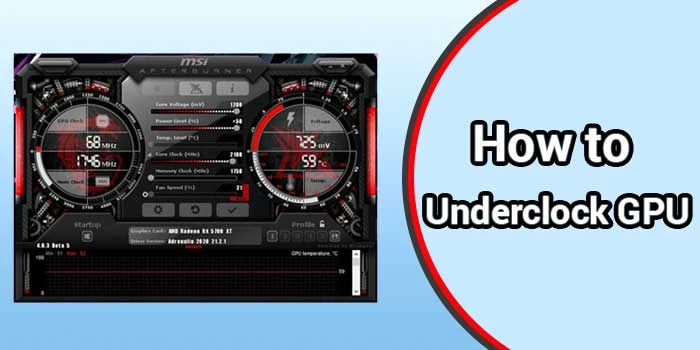by Malcolm Woods
GPU is the short term used to describe Graphics Processing Unit or commonly known as the graphics card. Underclocking, on the other hand, means modifying the circuit's time settings to a lower rate on a computer/electronic device.
Overclocking, which is a more popular task, does the opposite. As underclocking isn't as popular as overclocking your devices (GPU, RAM), you might be struggling to figure out how to underclock GPU by yourself.
If you want to find out whether you should underclock your GPU or not, why you should do it, and a detailed step-by-step process of how you should do it, we are here to help you through it all.
Contents

You don't necessarily need to tweak your default GPU settings. You can consider underclocking your graphics card if:
You don't need your GPU to function at full capacity constantly. In this way, you can ensure you are saving energy and some electricity bill.
Your GPU heats up noticeably - especially during hot weathered days, and you are unable to find other solutions to keep it normal.
Your graphics card has gotten old and no longer runs/functions properly.
You need to install games/software that are beyond your graphics card's capability.
Certainly, there are quite a few benefits to underclocking your GPU. Some benefits that we can mention are:
When your GPU has a lower clock speed, your hardware's power consumption is reduced. This also means a reduction in the electric bill.
When clock speed is lower, your fan will also be at a lower speed. This will result in the GPU running at a lower temperature and prevent overheating.
This is an added benefit of the previous one, i.e., fans being slower. As the temperature is now lower and the fan runs slower, it can run at a quieter speed, assuring a smoother experience.
Here's the detailed step-by-step guide for you to follow.
To start underclocking your GPU, you need a software application. This is way easier and less complicated compared to days when technologies were less advanced and entering BIOS tweaking around a lot of settings were needed to underclock GPU.
Many applications are available nowadays to carry out this task, such as ASUS GPU Tweak, EVGA Precision XOC, NZXT Cam, etc. However, the most popular, common, and easy one is MSI Burner.
It is an open-source, easily available hardware monitoring and overclocking software. This user-friendly interface helps adjust GPU variables such as temperature, voltage, speed of both core clock and memory clock, etc.
Even though it is widely used and popular for overclocking, it is equally great and easy to underclock your GPU with this as well. So, first things first, you need to acquire this software, which you can download online.
Install and set it up on your computer with the set-up wizard as you usually do with any software. Before you proceed, open your MSI Burner to check and ensure if the graphics card is being detected by the software.
When you run/open the software, you will notice adjustable options/settings on your screen. The core clock, which tracks and indicates the clock speed of the GPU in MHz, is listed on the middle left, along with memory speed.
The voltage and temperature settings can be found on the right. You will also notice a graph of temperature plotted against time at the bottom of the utility screen.
Before we change anything, you might want to notice and note down the original number/position of everything, as those are the default settings of your graphics card.
Thankfully, there is a reset option in case you need to change back to the default settings and have forgotten how they originally were.
You'll find a slider at the bottom that can tweak clock speed, which we are going to use to underclock our GPU. Move the core clock slider to the left to decrease clock speed to your desired level.
How much you should decrease it completely depends on the purpose/reason that you are underclocking the graphics card for.
When you are satisfied with the changes you have made and don't need to perform any further tasks, it is safe to say you are finished modifying your GPU. Simply click the "apply" button to apply the changes and save them. You can then go ahead and close the software application.
If you want, you can monitor your GPU for stability. You can set up a custom fan curve in the same software, plotting the fan speed against temperature to monitor the progress. You can also perform a stress test on your GPU to see how it performs under a heavy workload.
Now, if your underclocking is as successful as needed, you will notice an increase in stability and a decrease in temperature than usual during stress testing.
You may not need an overclocked GPU like most of the people around you. If you are mostly using your device to surf the web or for entertainment purposes like listening to mp3, watching movies, or even laptop gaming, etc., and are certain that you don't need that much of your GPU's current capacity, you can surely go ahead and underclock your GPU.
Now that you know how to underclock GPU, you can safely and easily decrease your electricity and power consumption, your energy bill, create lesser heat waste. This will also allow you to experience a smoother, quieter function of your device without hampering the performance.
 |
 |
 |
 |

About Malcolm Woods
Malcolm Woods is a blogger who enjoys writing about technology and solar power. He has a passion for learning new things, and loves to share his knowledge with others. Malcolm is also an advocate for sustainable living, and believes that everyone has a responsibility to do their part in preserving our planet.
 |
 |
 |
 |
Go for the FREE Gifts. Or check out for free energy books from our best collection.
Remove Ad block to reveal all the secrets. Once done, hit a button below
 |
 |
 |
 |